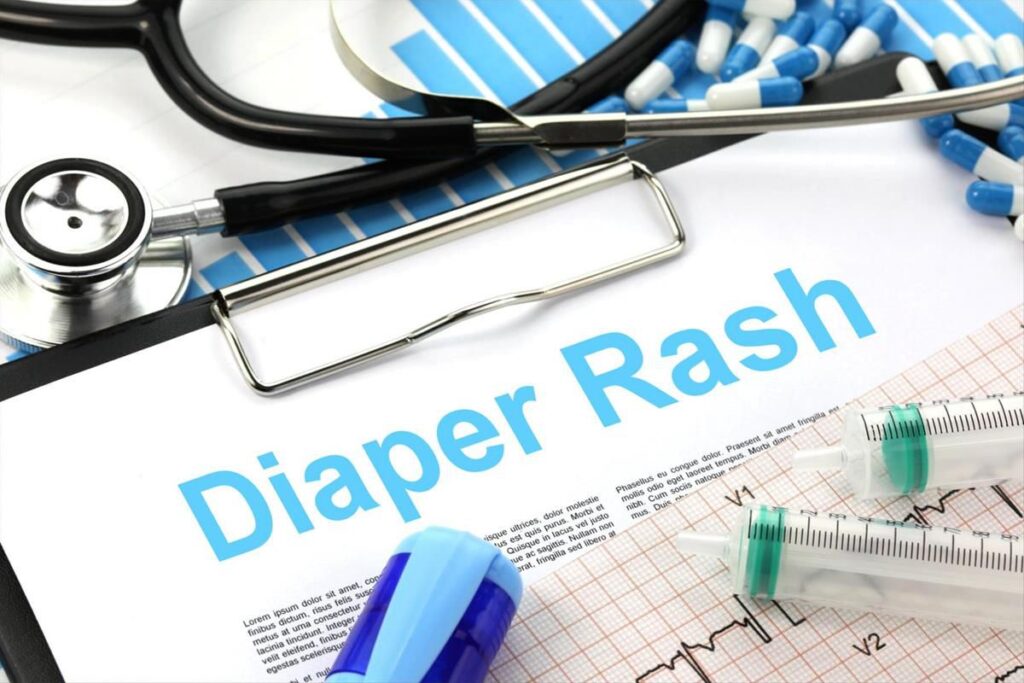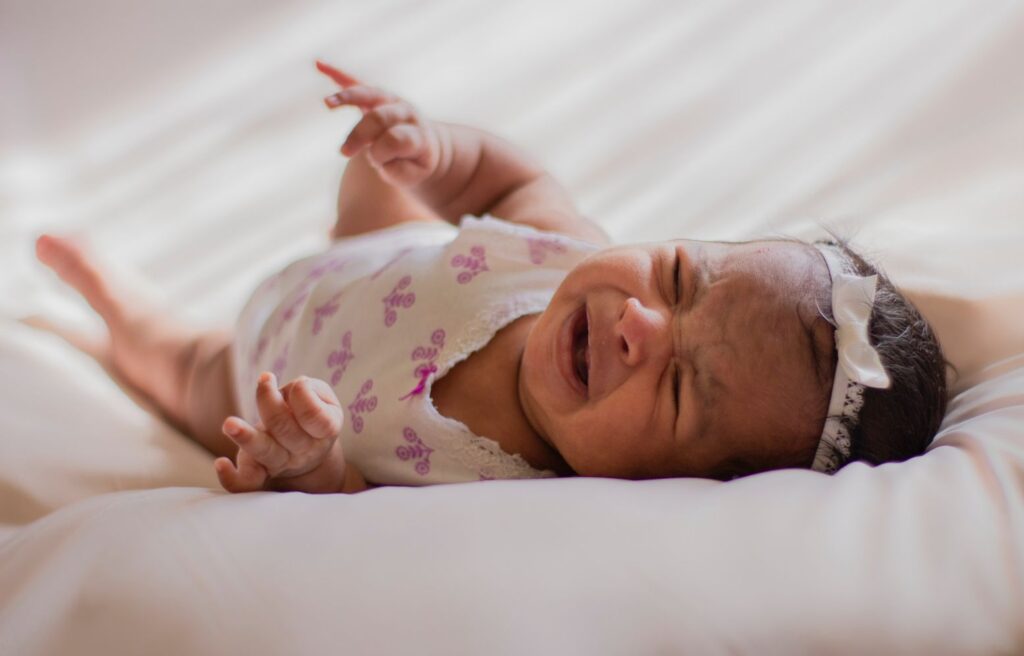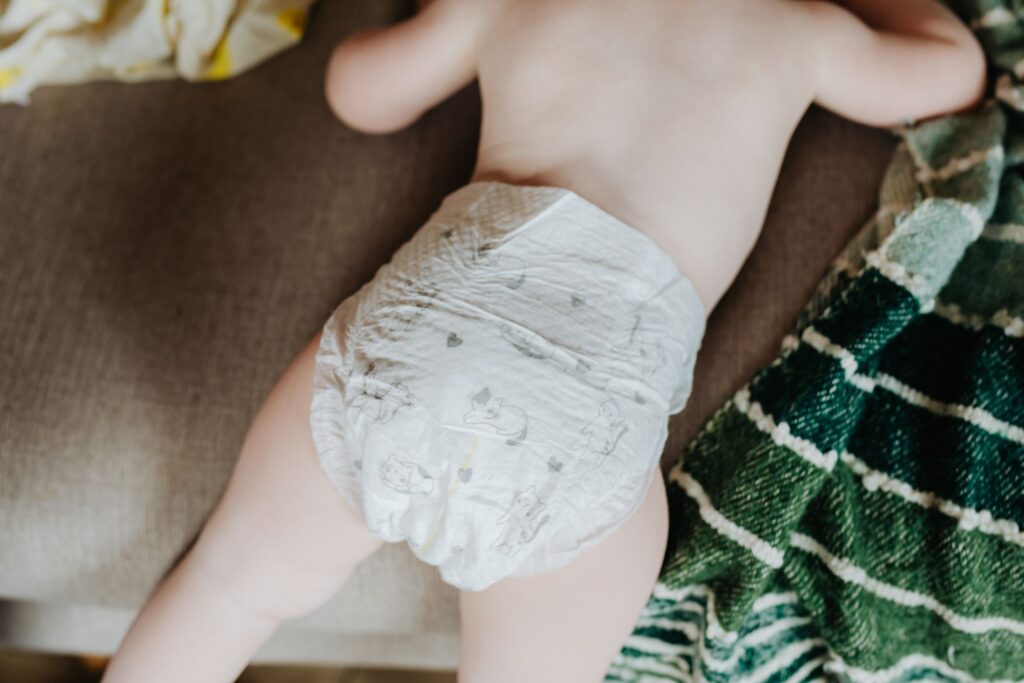Table of Contents
Introduction
Diaper rash is one of babies’ and toddlers’ most common skin conditions worldwide. This type of rash typically occurs when a child with sensitive skin comes into contact with urine, feces, or stool on the bottom.
It can also be caused by an allergic reaction to ingredients found in diapers, such as perfumes or dyes. Less often, diaper rash may be caused by a bacterial infection or yeast infection from bacteria on the baby’s bottom rubbing off onto their sensitive skin.

Diaper Rash Causes might vary, but it is important to know that these types of rashes are not contagious, so you do not need to worry about catching them from other family members or caregivers as some infectious diseases may cause.
In most cases, it is not a medical emergency and will usually clear up within a few days or weeks. In the meantime, it is important to understand what causes diaper rash and what treatments will work best for your baby.
It develops when a blockage of the pores lines the skin. This blockage allows for bacteria to breed and release toxins into the skin. The most common symptoms include redness, burning, and itching in the affected areas.
It should be treated as soon as it appears to prevent further irritation and infection. If a child has it frequently, you should consult your healthcare professional to determine the cause of the rash. This will help you decide on the best treatment for diaper rashes.
Symptoms of a Diaper Rash

According to the National Eczema Association, this skin condition affects 7 to 35 percent of infants. While several over-the-counter treatments are available, it’s always best to catch the rash early and treat it before it gets out of control. Here are diaper rash symptoms every parent should know.
- Excessive crying – If your baby is suddenly extra fussy, it could be a sign that they’re experiencing discomfort from a diaper rash. If you notice your baby crying more than usual, especially during or after a diaper change, it’s worth checking for other signs.
- Skin that looks red and irritated – One of the most obvious signs of diaper rash is red, inflamed skin in the diaper area. This can occur on the buttocks, thighs, or genitals. The skin may also be warm to the touch.
- Small raised bumps on the skin – You may also notice small raised bumps on your baby’s skin. These bumps are usually red or white and may be filled with pus.
- Scaly or cracked skin – Another symptom to look out for is scaly or cracked skin in the diaper area. This is often a sign that the rash has been present for some time and has not been properly treated.
- Pain or discomfort when urinating – If your baby seems to be in pain or discomfort, this could be a sign that they have a UTI (urinary tract infection). While UTIs are more common in older children and adults, they can also occur in babies and toddlers. If you suspect your child has a UTI, speak to their doctor as soon as possible so that they can start treatment right away.
- Fever – In some cases, they can also cause a fever in babies and toddlers. If your child has a fever and any other symptoms of diaper rash, it’s important to speak to their doctor immediately, as this could be a sign of an infection.
- Chills – Chills are another possible symptom of an infection. Suppose your child is experiencing chills along with other symptoms of diaper rash. In that case, it’s important to seek medical help immediately, as this could signify sepsis – a potentially life-threatening condition caused by an infection.
- Flu-like symptoms – In some cases, you may also notice that your child has flu-like symptoms such as fatigue, lethargy, poor appetite, and muscle aches. These symptoms can occur along with any other signs of diaper rash and usually indicate that your child has developed an infection.
Diaper Rash Causes

To understand what causes diaper rash, it is first important to know exactly what you are dealing with. Many parents assume that diaper rash is the same as a simple case of irritation, but this condition is much more than that.
Diaper rash usually starts with small patches of red skin in the baby’s anus and lower regions. These spots may or may not be painful and might appear to be pimples or other types of skin infections at first glance.
The Causes are vast, but typically the spots will be raised above the skin and very tender for your baby to touch. As the condition develops, the skin around these spots may begin to peel and flake away, leaving your baby with red patches all over its bottom.
The skin may also crack or bleed, making it even more uncomfortable for your little one to sit or lie down. Diaper rash is one of the most common skin conditions a baby can have and is obvious even when they are wearing clothing over their sensitive areas.
It is important not to confuse this condition with other types of rashes on a child’s bottom, such as yeast infections or allergic reactions.
What Causes Diaper Rash?
- Irritation from urine or stool in a diaper – Probably the most common cause of diaper rash and always needs to be addressed immediately. This can occur when a diaper gets wet with urine or feces but also be aware that any time your baby sits or lies down on their bottom in a wet diaper, this can irritate their skin and cause a rash.
- Using products made for adults – Many people mistakenly assume that the wrong products for babies cause diaper rashes, but this is not true. Often, the main culprits for adult products causing rashes are the ingredients used to make them.
Most people know that certain scents and dyes used in adult products are unsafe for children, but they often do not realize that the same can be true for baby products.
Sunblock or insect repellents tend to be strong, and many contain chemicals too strong for baby skin. Other common ingredients in adult products include perfumes and deodorizers, which can cause irritation or even an allergic reaction. - Bacterial infections – Diaper rash is very common among babies suffering from urinary tract infections. These rashes may also be caused by contact with certain types of bacteria, such as group A strep, one of the most common UTIs. This is one of the most common rashes and develops similarly. A child may experience flaky, red skin that comes into contact with urine or feces on their bottom, and the skin may begin to peel or bleed.
- Yeast infection – Diapering is not only an activity in a baby’s nursery but also a favorite pastime for many adults. Some adults who spend much time out of the house with their babies often use products such as baby powder, which may contain chemicals and fragrances too strong for a baby’s sensitive skin.
- Mechanical irritation to the skin – Diaper rash can also be caused by mechanical irritation from rubbing against a rough diaper or one that is too tight. This is a common cause of diaper rash, especially among babies with overly sensitive skin.
- Sometimes, diaper rash is caused by irritation to the baby’s bottom – this could be because their diapers are too tight or there is a reaction to their nappy cream.
These problems should clear up within three days if you keep your baby clean and ensure that the surrounding skin is completely dry. If you see any signs of infection, like pus, or if your baby has been diagnosed with an infection in the past, make sure you mention this to a doctor before using any nappy rash treatment on them.
Diaper Rash Prevention and Treatment
- One of the most important things you can do is ensure that your baby’s bottom is completely dry after each diaper change.
It would help if you patted it gently with a clean and soft towel to ensure that there are no wet spots on their skin. After you have put on a new diaper, it won’t hurt to also apply a light layer of baby powder to their bottom so that no moisture can get trapped in the surrounding skin.
We suggest using an all-natural baby power like the one from Infantdry.
- Remember that changing diapers as soon as possible will help you treat any nappy rash more effectively – if your child’s nappy becomes soggy, you should change it immediately and then take some time out to clean their bum gently with warm water and mild soap before applying the diapers again.
- Once your baby has a nappy rash, you should keep the surrounding skin dry to prevent an infection. If your child has any infection – like thrush – applying a calendula and zinc oxide cream will help to soothe their irritated skin.
- You should also make sure that your baby’s bottom is kept as clean as possible by washing it with warm water and mild soap every day – this will ensure that they do not develop any yeast or bacterial infections in the first place and make sure that you can treat their diaper rash more effectively when it does do occur.
- Suppose you notice any redness or irritation on your baby’s bottom. In that case, you should take them to the doctor before using any nappy rash treatment on them – while it is likely that they have just developed a yeast infection, it is also possible that they may have contracted an infection.
- If the rash does not clear within two weeks, you should take your baby to the doctor immediately – this will allow them to ensure that everything is completely fine before trying any diaper rash treatment on them.
- If you are using disposable diapers, consider switching to cloth diapers until the rash clears up. Cloth diapers are less likely to irritate your baby’s skin because they allow more airflow than disposables.
- You should also make sure that they have nothing in their bottom at all before they go to sleep, or at least anything damp for a long period – you should gently pat them dry with a clean and soft towel after a bowel movement and then gently wipe away any fecal matter from around their bum to prevent any infection from occurring.

- Allow skin to breathe – Allow your baby’s bottom some time without a diaper. Place them on a blanket on their back or sit up supported so they can kick their legs and get some air to the area.
- Dust with cornstarch or arrowroot powder – These powders can help absorb moisture and keep the area dry, promoting healing. Apply after cleansing and before applying a barrier cream or ointment.
- Avoid harsh laundry detergents – Just like soap, laundry detergent can be harsh on your baby’s skin and should be avoided if possible. If you must use detergent, opt for a hypoallergenic or fragrance-free option to minimize irritation.
- Consider using probiotics – Probiotics help improve gut health and can also help clear up diaper rash by reducing inflammation throughout the body. You can give probiotics to your baby orally in the form of Drops, Powder, or Capsules, Or you can apply them topically in the form of Creams or Ointments. Consult with your pediatrician before giving probiotics to your baby, as they may interact with other medications they are taking.
Frequently Asked Questions about Diaper Rash
-
What does a bacterial diaper rash look like?
Common symptoms include red skin that looks like a sunburn and peeling, flaking, or scaling skin. Many babies with diaper rash have tender, swollen lumps on their skin.
A more severe diaper rash is caused by a yeast infection or a bacterial infection. The yeast infection, called candidal diaper dermatitis, causes thick, white patches.
A bacterial infection can cause pus-filled blisters or sores. If your baby is suffering from a more severe form, the CDC says you should seek medical care from your pediatrician.
-
How long does a diaper rash last?
The time required to heal depends upon the severity. It can take anywhere between 2 to 3 days to heal.
-
Is diaper rash painful for babies?
Although not all babies experience diaper rash, some may be left with painful skin irritation after wearing diapers. Observing redness and swelling in the groin area is normal after the diapers are worn for an extended period.
However, pink rashes are not painful; they are more irritating. Raw rashes, however, could be painful and aggravate when the baby urinates. They are more commonly referred to as diaper dermatitis.
-
When should I take my baby to the doctor for a diaper rash?
If the diaper rash persists, it is always better to visit the doctor. The baby’s pediatrician will examine the baby and may prescribe some medication to clear the rash.
-
How can I tell if my baby has a diaper rash?
You should see signs of redness and irritation on your baby’s bottom – these should clear up within a few days. If you notice that their skin looks dry where their diaper is, this could be why the rash has not gone away after a few days. Please read our detailed list of symptoms.
-
How can I ensure my baby is not developing a diaper rash?
You should change your baby’s nappy immediately after they have had an accident or when they wet themselves – follow this by patting them dry with a clean, soft and gentle towel.
-
What can I do to prevent my baby from developing a diaper rash?
You should avoid using any cream or ointment externally so that you do not irritate the skin on your baby’s bottom. Instead, you should clean their bottom gently with warm water and mild soap every day and ensure they have nothing in their bum before going to sleep.
-
I have tried everything, but my baby’s diaper rash has not started to clear up yet – what should I do?
You should consult a doctor for advice – you can try using cotton cloths made of the bamboo fiber to clean away any debris from around the area that is bothering your child.
-
Can I bathe my baby every day to avoid diaper rash?
Yes, doing this is one of the best ways to ensure that your baby does not develop any rash since it will keep their skin completely dry and clean.
Note: It is important to recognize that any medications or treatments discussed are not intended to diagnose, treat or cure any disease or illness. Before using anything in your baby’s care, always consult with your childcare provider.














